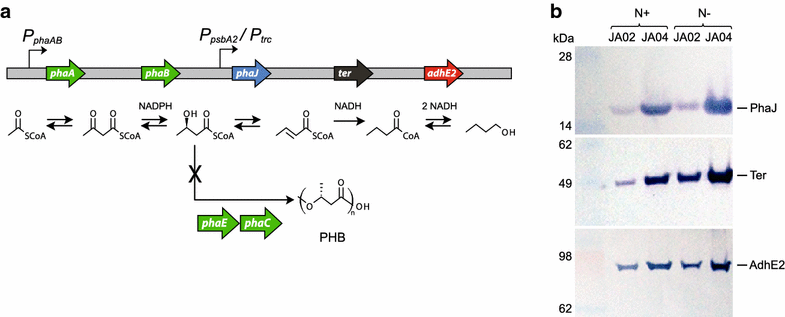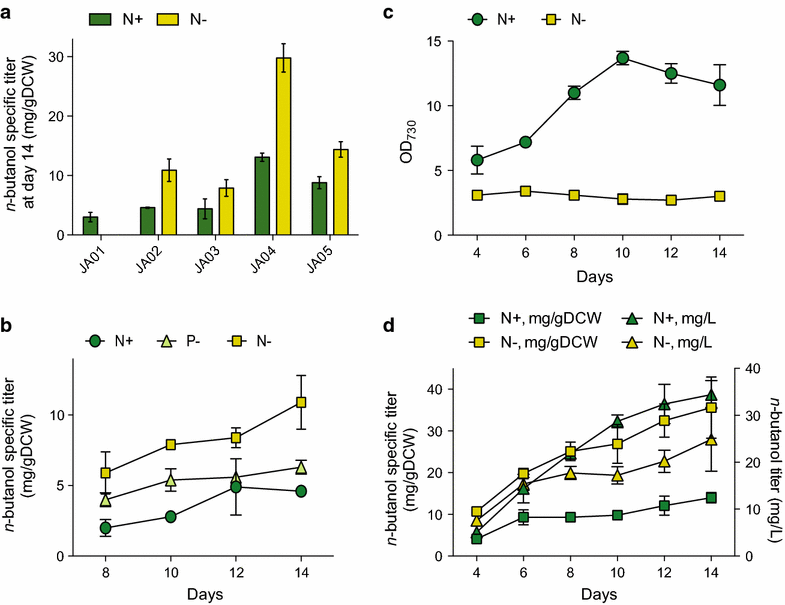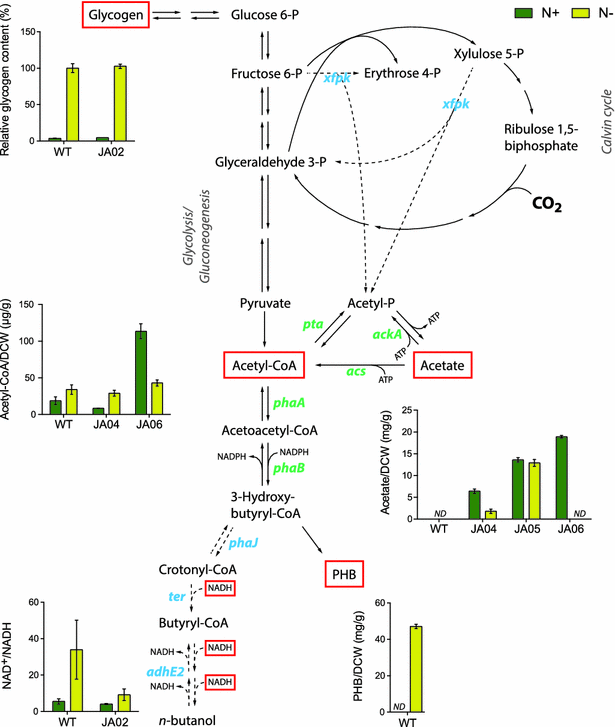Genetic and nutrient modulation of acetyl-CoA levels in Synechocystis for n-butanol production
- PMID: 26474754
- PMCID: PMC4609045
- DOI: 10.1186/s12934-015-0355-9
Genetic and nutrient modulation of acetyl-CoA levels in Synechocystis for n-butanol production
Abstract
Background: There is a strong interest in using photosynthetic cyanobacteria as production hosts for biofuels and chemicals. Recent work has shown the benefit of pathway engineering, enzyme tolerance, and co-factor usage for improving yields of fermentation products.
Results: An n-butanol pathway was inserted into a Synechocystis mutant deficient in polyhydroxybutyrate synthesis. We found that nitrogen starvation increased specific butanol productivity up to threefold, but cessation of cell growth limited total n-butanol titers. Metabolite profiling showed that acetyl-CoA increased twofold during nitrogen starvation. Introduction of a phosphoketolase increased acetyl-CoA levels sixfold at nitrogen replete conditions and increased butanol titers from 22 to 37 mg/L at day 8. Flux balance analysis of photoautotrophic metabolism showed that a Calvin-Benson-Bassham-Phosphoketolase pathway had higher theoretical butanol productivity than CBB-Embden-Meyerhof-Parnas and a reduced butanol ATP demand.
Conclusion: These results demonstrate that phosphoketolase overexpression and modulation of nitrogen levels are two attractive routes toward increased production of acetyl-CoA derived products in cyanobacteria and could be implemented with complementary metabolic engineering strategies.
Figures





Similar articles
-
Phosphoketolase pathway contributes to carbon metabolism in cyanobacteria.Nat Plants. 2015 Dec 7;2:15187. doi: 10.1038/nplants.2015.187. Nat Plants. 2015. PMID: 27250745
-
Improving biobutanol production in engineered Saccharomyces cerevisiae by manipulation of acetyl-CoA metabolism.J Ind Microbiol Biotechnol. 2013 Sep;40(9):1051-6. doi: 10.1007/s10295-013-1296-0. Epub 2013 Jun 13. J Ind Microbiol Biotechnol. 2013. PMID: 23760499
-
Exploring and increased acetate biosynthesis in Synechocystis PCC 6803 through insertion of a heterologous phosphoketolase and overexpressing phosphotransacetylase.Metab Eng. 2025 Mar;88:250-260. doi: 10.1016/j.ymben.2025.01.008. Epub 2025 Jan 23. Metab Eng. 2025. PMID: 39863056
-
Metabolic engineering of Saccharomyces cerevisiae for production of butanol isomers.Curr Opin Biotechnol. 2015 Jun;33:1-7. doi: 10.1016/j.copbio.2014.09.004. Epub 2014 Oct 4. Curr Opin Biotechnol. 2015. PMID: 25286420 Review.
-
Strategies for optimizing acetyl-CoA formation from glucose in bacteria.Trends Biotechnol. 2022 Feb;40(2):149-165. doi: 10.1016/j.tibtech.2021.04.004. Epub 2021 May 5. Trends Biotechnol. 2022. PMID: 33965247 Review.
Cited by
-
Improved sugar-free succinate production by Synechocystis sp. PCC 6803 following identification of the limiting steps in glycogen catabolism.Metab Eng Commun. 2016 May 3;3:130-141. doi: 10.1016/j.meteno.2016.04.003. eCollection 2016 Dec. Metab Eng Commun. 2016. PMID: 29468119 Free PMC article.
-
Kinetic modeling of the Calvin cycle identifies flux control and stable metabolomes in Synechocystis carbon fixation.J Exp Bot. 2019 Feb 5;70(3):973-983. doi: 10.1093/jxb/ery382. J Exp Bot. 2019. PMID: 30371804 Free PMC article.
-
The novel PII-interactor PirC identifies phosphoglycerate mutase as key control point of carbon storage metabolism in cyanobacteria.Proc Natl Acad Sci U S A. 2021 Feb 9;118(6):e2019988118. doi: 10.1073/pnas.2019988118. Proc Natl Acad Sci U S A. 2021. PMID: 33526690 Free PMC article.
-
Improving productivity of citramalate from CO2 by Synechocystis sp. PCC 6803 through design of experiment.Biotechnol Biofuels Bioprod. 2024 Dec 5;17(1):143. doi: 10.1186/s13068-024-02589-z. Biotechnol Biofuels Bioprod. 2024. PMID: 39639409 Free PMC article.
-
Improved lipid production via fatty acid biosynthesis and free fatty acid recycling in engineered Synechocystis sp. PCC 6803.Biotechnol Biofuels. 2019 Jan 4;12:8. doi: 10.1186/s13068-018-1349-8. eCollection 2019. Biotechnol Biofuels. 2019. PMID: 30622650 Free PMC article.
References
-
- Lan EI, Ro SY, Liao JC. Oxygen-tolerant coenzyme A-acylating aldehyde dehydrogenase facilitates efficient photosynthetic n-butanol biosynthesis in cyanobacteria. Energy Environ Sci. 2013;6:2672–2681. doi: 10.1039/c3ee41405a. - DOI
Publication types
MeSH terms
Substances
LinkOut - more resources
Full Text Sources
Other Literature Sources

